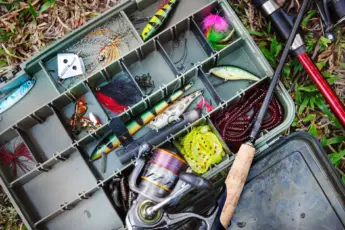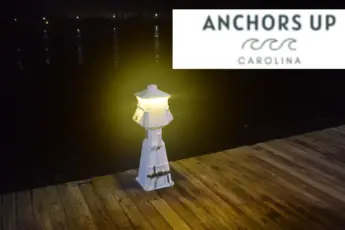One of the most fun and effective methods to catch fish is by sight fishing. I enjoy sight fishing because it adds an extra element to the sport. Rather than blind casting or trolling, you’re making a precise cast to land a lure or bait where the fish will eat. However, sight fishing requires technique, patience, and important gear. Without question, after sight fishing once, you’ll be hooked. So, what is sight fishing? Additionally, learn the key factors to catch more fish.
What Bodies Of Water Can You Catch Fish Sight Fishing
Without question, you can sight fish in every body of water. I have had the opportunity to catch fish by sight from up in Canada all the way through the Caribbean. Here are the bodies of water where you can catch fish while sightfishing.
Lakes
To be honest, I have gone sight fishing along the shorelines of the Great Lakes. However, sight fishing is also possible in lakes measuring a fraction of the size.
Again, the water visibility is highly variable therefore, your ability to see into the water changes based on the lake.
Some of the most common sight casted fish include largemouth bass, striped bass, trout, gar, and even the occasional walleye at dusk or dawn.
Rivers
One of the most often overlooked areas to sight fish are rivers. I personally have sight fished rivers for both freshwater and saltwater species.
It should be noted that some rivers are low in visibility as a result of the fast moving water and mud bottoms. Alternatively, others are crystal clear, depending on the location.
Freshwater anglers often sight cast for bass, gar, and a variety of panfish. Conversely, saltwater anglers in rivers target redfish, shark, including bonnethead, and the occasional sturgeon.
Creeks
Without question, trout fishing is a popular sport among anglers in the mountains throughout the southeastern United States.
Anglers sight fish with fly rods or spinning reels for varieties of trout lurking beneath rocks and in deep pools. Importantly, wadding allows better visibility because you move your location based on lighting.
Inland Coastal Waters
Sight casting for inshore fish, including redfish, shark, tarpon, snook, and other species, is highly popular among anglers.
Flats and inshore boats are often fitted with an elevated platform. The elevated platform allows casters or spotters to locate fish as they cruise along the shoreline or open water.
Open Oceans
Undoubtedly, the open ocean is one of my favorite places to sight fish. I have caught fish by sight, from small center consoles to large sport fishing vessels.
As you know, the open ocean has an abundance of species, many of which roam the surface. For this reason, sight casting is excellent when it comes to top gamefish, including mahi mahi, tuna, cobia, and more.
It should be noted that the higher above the surface of the water, the more easy it is to spot lone or schools of fish. I was fortunate to be guiding anglers from towers, keeping them on the schools while they cast.
Lastly, the water is most often clear, allowing you to spot fish beneath the surface.
What Is Sight Fishing? Essential Gear And Factors
In order to be more successful at catching fish by sight fishing, you’re going to want to bring along the right gear. Again, sight fishing is spotting a fish, making an accurate cast, luring a strike, and landing the fish. Bring along this essential gear to improve your chances of catching fish.
Polarized Glasses
Without a doubt, glare on the water inhibits the ability to spot fish swimming beneath the surface.
Importantly, the glasses reduce the glare on the surface, which allows you to spot fishing under the top of the water.
I highly suggest buying a high quality pair of polarized glasses. These include Costa Del Mar or Maui Jim.
An Elevated Surface
No matter if you’re sight casting from a boat or from the shore, use elevation to your advantage. Unquestionably, being elevated above the top of the water provides the best position to spot fish.
For this reason, you’ll not only be better able to spot the fish but also make a more precise cast.
Quality Fishing Rod, Reel, And Line
Don’t expect a good outcome if the line comes off the spool of your reel in a knotted up ball. I recommend ensuring the line flows with ease off the reel compared to becoming a tangled mess.
In addition to avoiding a fishing line birds nest is ensuring the line flows well through the guides. Without a doubt, damaged guides will prevent the line from flowing smoothly during a cast and when retrieving the bait or a fish.
Lastly, the reel is also a critical component in the equation. Don’t expect to land a fish hooked while sight casting if the reel bearings are at risk of seizing up. In all, make sure your equipment is in good working order.
Accuracy In Casting
All too often, I have seen anglers make two major mistakes when sight casting. The first is casting and plopping the lure or bait right on top of the fish’s head. Trust me, this won’t work, as it will quickly spook the fish away.
Secondly, anglers rush the casting process and cast wildly away from the location of the fish. Unfortunately, by the time the angler reels up and makes another attempt, the fish has often moved on.
With that being said, I recommend becoming comfortable with your gear by practicing casts before sight casting. I used to place a target in a backyard and cast my rod and reel at the target for practice. It sounds funny, I know, but when it comes down to needing precision, it will pay off.
What Is Sight Fishing? A Lot Goes Into It
Without question, understanding the definition of sight fishing is elementary compared to the overall picture. The necessity of high performing equipment and precise casting skills are critical to land more fish. For this reason, I suggest practicing casting, investing in quality gear, and performing routine maintenance on fishing equipment.







